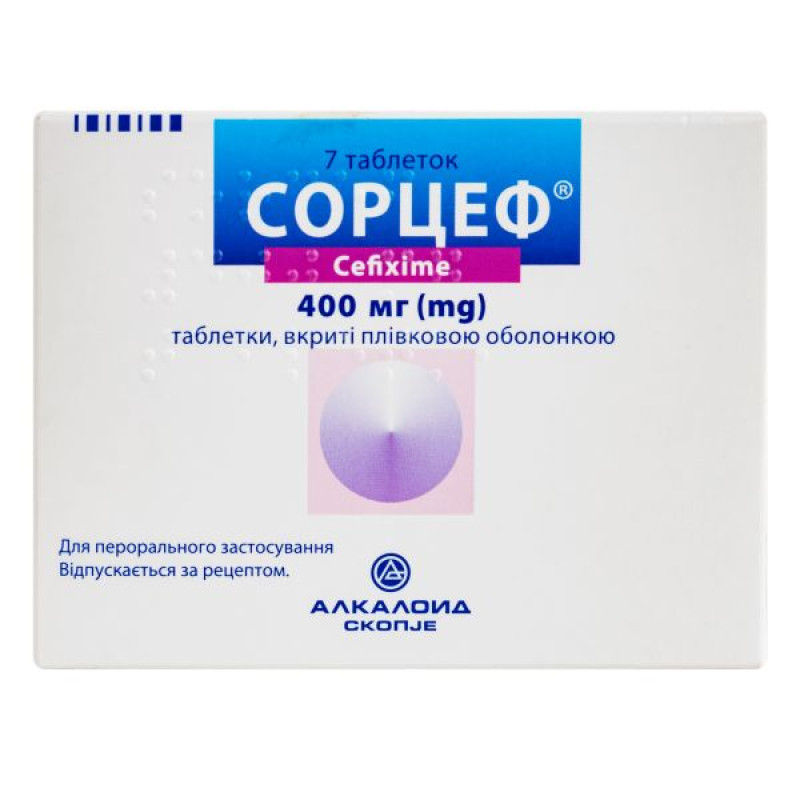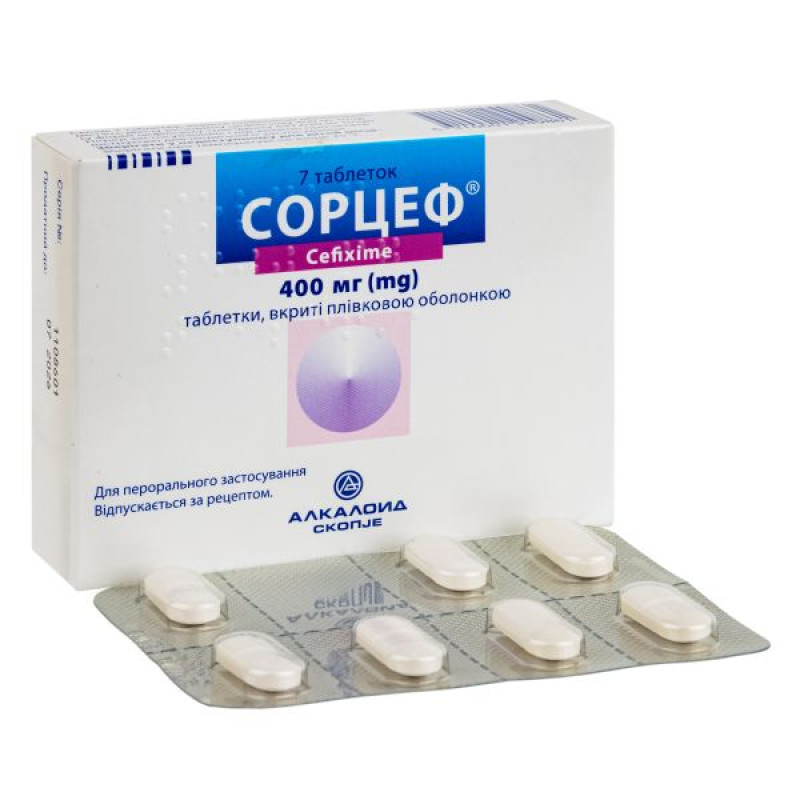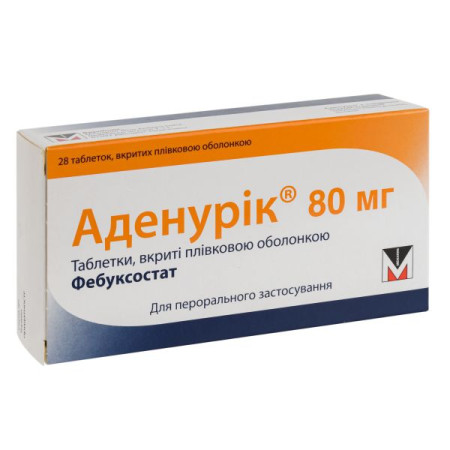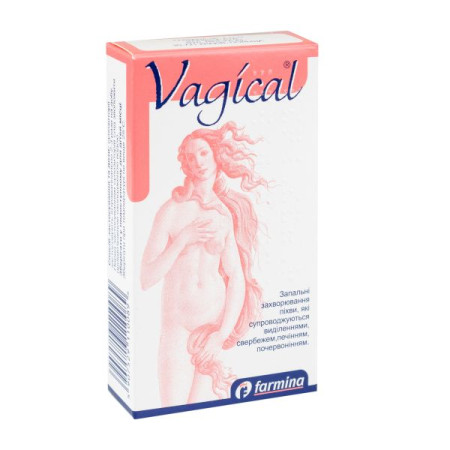Sorcef film-coated tablets 400 mg blister No. 7
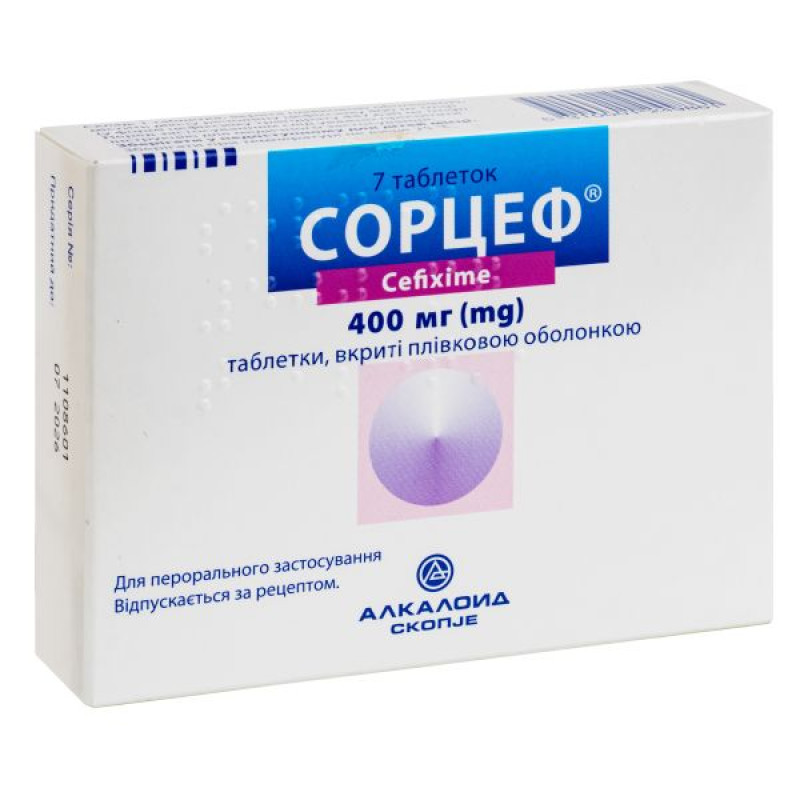
Instructions Sorcef film-coated tablets 400 mg blister No. 7
Composition
active ingredient: cefixime;
1 film-coated tablet contains cefixime 400 mg (as cefixime trihydrate 447.630 mg);
Excipients: gelatin; calcium hydrogen phosphate, dihydrate; corn starch; pregelatinized starch; magnesium stearate; sodium lauryl sulfate; microcrystalline cellulose; hypromellose; macrogol 4000; titanium dioxide (E 171).
Dosage form
Film-coated tablets.
Main physicochemical properties: oblong biconvex tablets, film-coated, creamy white, with a break line on one side.
Pharmacotherapeutic group
Antibacterials for systemic use. Beta-lactam antibiotics. Third-generation cephalosporins. ATX code J01D D08.
Pharmacological properties
Pharmacodynamics.
Cefixime is a third-generation cephalosporin antibiotic for internal use. In vitro, it exhibits significant bactericidal activity against a wide range of gram-positive and gram-negative microorganisms.
Clinically effective in the treatment of infections caused by the most common pathogens, including Streptococcus pneumoniae, Streptococcus pyogenes, E.coli, Proteus Mirabilis, Klebsiella species, Haemophilus influenzae (beta-lactamase positive and negative), Branhamella catarrhalis (beta-lactamase positive and negative) and Enterobacter species. Has a high degree of stability in the presence of beta-lactamases.
Most strains of enterococci (Streptococcus faecalis, group D Streptococci) and Staphylococci (including coagulase-positive, coagulase-negative and methicillin-resistant strains) are resistant to cefixime. In addition, most strains of Pseudomonas, Bacteroides fragilis, Listeria monocytogenes and Clostridia are resistant to cefixime.
Pharmacokinetics.
Absorption. The absolute bioavailability of cefixime after oral administration is 22-54%. Since the presence of food does not significantly affect absorption, cefixime can be administered without regard to food intake. The maximum serum level after taking the recommended doses for adults or children is 1.5 to 3 mcg/ml. With repeated dosing, there is little or no accumulation of cefixime.
Distribution: Cefixime is almost completely bound to albumin, with an average free fraction of approximately 30%.
Metabolism: Metabolites of cefixime have not been isolated from human serum or urine.
Excretion: Cefixime is excreted mainly unchanged in the urine. The predominant mechanism is glomerular filtration.
There is no data on the penetration of cefixime into breast milk.
Indication
Infectious and inflammatory diseases caused by microorganisms sensitive to the drug:
upper respiratory tract infections (including otitis media) and other upper respiratory tract infections (sinusitis, pharyngitis, tonsillitis of bacterial etiology) in case of known or suspected resistance of the pathogen to other commonly used antibiotics, or in case of risk of treatment failure;
lower respiratory tract infections (including acute bronchitis and exacerbation of chronic bronchitis);
urinary tract infections (including cystitis, cystourethritis, uncomplicated pyelonephritis).
Clinically effective in the treatment of infections caused by the most common pathogenic microorganisms, including Streptococcus pneumoniae, Streptococcus pyogenes, E.coli, Proteus mirabilis, Klebsiella species, Haemophilus influenzae (beta-lactamase positive and negative), Branhamella catarrhalis (beta-lactamase positive and negative) and Enterobacter species. Has a high degree of stability in the presence of beta-lactamases.
Most strains of enterococci (Streptococcus faecalis, group D Streptococci) and Staphylococci (including coagulase-positive, coagulase-negative and methicillin-resistant strains) are resistant to cefixime. In addition, most strains of Pseudomonas, Bacteroides fragilis, Listeria monocytogenes and Clostridia are resistant to cefixime.
Contraindication
Confirmed hypersensitivity to cephalosporin antibiotics or to other components of the drug; hypersensitivity to penicillins; porphyria.
Interaction with other medicinal products and other types of interactions
Blockers of tubular secretion (allopurinol, probenecid, diuretics and other blockers of tubular secretion) increase the maximum concentration of cefixime in the blood serum, slowing down the excretion of cefixime by the kidneys, which may lead to symptoms of overdose.
Salicylic acid increases free cefixime by 50% due to displacement of cefixime from protein binding sites; this effect is concentration-dependent.
Concomitant use with carbamazepine may cause an increase in its plasma concentration, therefore it is advisable to monitor the level of carbamazepine in the blood plasma.
When cefixime is used in combination with potentially nephrotoxic substances (aminoglycosides, colistin, polymyxin, viomycin) or potent diuretics (ethacrynic acid, furosemide), there is an increased risk of developing renal failure.
Nifedipine increases bioavailability, but clinical interactions have not been determined.
As with other cephalosporins, increases in prothrombin time have been reported in some patients, therefore caution should be exercised in patients receiving anticoagulant therapy.
Cefixime should be used with caution in patients receiving coumarin-type anticoagulants, such as warfarin potassium. Since cefixime may potentiate the effects of anticoagulants, an increase in prothrombin time with or without clinical bleeding may occur.
During treatment with cefixime, a false-positive direct Coombs test and a false-positive reaction to glucose in the urine when using copper sulfate tablets, Benedict's or Fehling's solutions are possible. It is recommended to use a glucose oxidase test to determine glucose in the urine.
Application features
Beta-lactams, including cefixime, increase the risk of encephalopathy (which may include convulsions, confusion, impaired consciousness, movement disorders) in patients, especially in cases of overdose and renal failure.
Severe cutaneous adverse reactions such as toxic epidermal necrolysis, Stevens-Johnson syndrome, and drug rash with eosinophilia and systemic symptoms (DRESS) have been reported in some patients with cefixime. If severe cutaneous adverse reactions occur, cefixime should be discontinued and appropriate treatment should be initiated.
Cefixime should be administered with caution to patients who have had hypersensitivity reactions to other drugs.
There have been cases of severe reactions (including anaphylactic shock) to cefixime. If an allergic reaction to cefixime develops, the drug should be discontinued and appropriate therapy should be initiated.
Cases of drug-induced hemolytic anemia, including severe cases with fatal outcomes, have been described with cephalosporins. Hemolytic anemia has also been reported following repeated use of cephalosporins (including cefixime).
Cefixime should be used with caution in patients with significant renal impairment (see Dosage in renal impairment).
As with other cephalosporins, cefixime may cause acute renal failure, including tubulointerstitial nephritis as the underlying pathological condition. If acute renal failure occurs, cefixime should be discontinued and appropriate therapy and/or measures should be taken.
Caution should be exercised when prescribing the drug in the presence of a history of bleeding, gastrointestinal diseases, especially such as ulcerative colitis, regional enteritis or colitis on the background of use, as well as in case of impaired liver function.
The safety of cefixime in premature infants or neonates has not been established.
Treatment with broad-spectrum antibiotics may disrupt the normal intestinal flora, which can lead to overgrowth of toxin-producing Clostridium difficile, a major cause of antibiotic-associated diarrhea. Pseudomembranous colitis has been associated with the use of broad-spectrum antibiotics (including macrolides, semisynthetic penicillins, lincosamides, and cephalosporins). Therefore, it is important to consider the diagnosis in patients who develop diarrhea during or after antibiotic use. Symptoms of pseudomembranous colitis may develop during or after antibiotic treatment is discontinued.
Treatment of pseudomembranous colitis should include sigmoidoscopy, appropriate bacteriological studies, and fluid, electrolyte, and protein supplementation. If the condition does not improve after discontinuation of the drug or symptoms become severe, oral vancomycin should be administered. Vancomycin is the drug of choice for the treatment of antibiotic-associated pseudomembranous colitis (caused by
C. Difficile). Other causes of colitis must be ruled out.
In case of simultaneous use of cefixime with aminoglycosides, polymyxin B, colistin, loop diuretics (furosemide, ethacrynic acid) in high doses, it is necessary to carefully monitor renal function. After prolonged use of cefixime, it is necessary to check the state of hematopoiesis function.
During treatment, a positive direct Coombs test and a false-positive urine test for glucose are possible.
Cephalosporins increase the toxicity of alcohol, so it is not recommended to drink alcoholic beverages during treatment with cefixime.
Use during pregnancy or breastfeeding
Reproduction studies in mice and rats at doses approximately 400 times the human dose have shown no evidence of impaired fertility or foetal harm due to cefixime. In rabbits at doses up to 4 times the human dose there was no evidence of teratogenicity; a high incidence of abortions and maternal mortality was observed, which is expected given the known sensitivity of rabbits to changes in gut microflora caused by antibiotics.
There are no data on the use of the drug during pregnancy. Cefixime crosses the placenta.
The drug should not be used during pregnancy or breastfeeding, except in cases of extreme necessity as prescribed by a doctor.
Ability to influence reaction speed when driving vehicles or other mechanisms
No effect. Patients who experience CNS adverse reactions (e.g. dizziness) while taking Sorcef® should refrain from driving or operating other machinery while taking the drug.
Method of administration and doses
Food intake does not affect the absorption of cefixime. The usual course of treatment is
7 days, if necessary - up to 14 days. In the treatment of uncomplicated cystitis, the course of treatment is 3 days.
Adults and children over 12 years of age with a body weight of more than 50 kg: the recommended dose is 400 mg (one tablet) per day once or 200 mg (half a tablet) every 12 hours, depending on the severity of the disease.
Elderly patients: prescribe the drug in the recommended adult dose. Renal function should be monitored and the dose adjusted in severe renal insufficiency (see "Dosage in renal insufficiency").
Dosage in renal failure: Cefixime can be used in cases of impaired renal function. For patients with creatinine clearance of 20 ml/min or higher, the usual dose and dosing regimen should be used. For patients with creatinine clearance below 20 ml/min, it is not recommended to exceed a dose of 200 mg (half a tablet) once daily. This also applies to patients on continuous ambulatory peritoneal dialysis or hemodialysis.
Children
Children under 12 years of age are recommended to use the drug in a different dosage form.
Overdose
No cases of overdose were observed. Adverse reactions observed when using the drug in doses up to 2 g in healthy study participants did not differ from adverse reactions observed in patients who took the drug in recommended doses.
Symptoms: increased manifestation of adverse reactions.
Treatment: Gastric lavage, symptomatic and supportive therapy. There is no specific antidote. Hemodialysis or peritoneal dialysis only slightly contribute to the removal of cefixime from the body.
Adverse reactions
From the blood and lymphatic system: eosinophilia, hypereosinophilia, agranulocytosis, leukopenia, neutropenia, granulocytopenia, hemolytic anemia, thrombocytopenia, thrombocytosis, hypoprothrombinemia, thrombophlebitis, prolongation of thrombin and prothrombin time (bleeding and bruising without apparent cause), purpura.
On the part of the digestive system: stomach cramps, abdominal pain, diarrhea*, dyspepsia, nausea, vomiting, flatulence, dysbacteriosis, candidiasis of the oral mucosa, stomatitis, glossitis.
Liver and biliary tract: jaundice, hepatitis, cholestasis.
Infectious and parasitic diseases: pseudomembranous colitis.
Laboratory parameters: increased aspartate aminotransferase (AST), increased alanine aminotransferase (ALT), increased bilirubin in the blood, increased blood urea, increased serum creatinine.
Metabolism and nutrition disorders: anorexia (loss of appetite).
Nervous system: headache, dizziness, dysphoria, hyperactivity; cases of convulsions have been reported with the use of cephalosporins, including cefixime (frequency unknown).
Beta-lactams, including cefixime, increase the risk of encephalopathy (which may include convulsions, confusion, impaired consciousness, movement disorders) in patients, especially in cases of overdose and renal failure (frequency unknown).
Hearing disorders: hearing loss.
Respiratory, thoracic and mediastinal disorders: dyspnea.
Renal and urinary disorders: acute renal failure, including tubulointerstitial nephritis as the underlying pathological condition, hematuria.
Immune system and skin and subcutaneous tissue disorders: anaphylactic reaction; serum sickness-like reactions; drug rash with eosinophilia and systemic symptoms (DRESS); fever; facial swelling; hypersensitivity reactions in the form of rash, itching, drug fever and arthralgia, including rare cases of urticaria or angioedema. These reactions usually disappeared after discontinuation of therapy; erythema multiforme exudative (including Stevens-Johnson syndrome), toxic epidermal necrolysis (Lyell's syndrome).
Reproductive system and breast disorders: genital itching, vaginitis caused by Candida.
General disorders: weakness, fatigue, increased sweating, inflammation of the mucous membranes.
* Diarrhea, usually associated with higher doses. Moderate to severe diarrhea has been reported; discontinuation of therapy is warranted. Cefixime should be discontinued if severe diarrhea occurs.
Expiration date
3 years.
Do not use after the expiry date stated on the packaging.
Storage conditions
Store at a temperature not exceeding 25 ° C. Keep out of the reach of children.
Packaging
Film-coated tablets, 400 mg.
5 tablets in a blister, 1 or 2 blisters in a cardboard box.
7 tablets in a blister; 1 blister in a cardboard box.
Vacation category
According to the recipe.
Producer
ALKALOID AD Skopje.
Alexander the Great Boulevard, 12, Skopje, 1000, Republic of North Macedonia.
There are no reviews for this product.
There are no reviews for this product, be the first to leave your review.
No questions about this product, be the first and ask your question.







